Prediction of the Water-Bearing Properties of Weathered Bedrock Aquifers Based on Kernel Density Estimator–Bayes Discriminant
Abstract
1. Introduction
2. Overview of the Study Area
2.1. General Situation of Geology
2.2. General Situation of Hydrogeology
2.3. General Situation of the Coal Seam
3. Kernel Density Estimator–Bayes Discriminant
4. Construction of Discriminant Models
4.1. Selection of the Main Control Factors and Normality Test
- 1.
- Weathered bedrock thickness
- 2.
- Core recovery rate
- 3.
- Degree of weathering
- 4.
- Lithological combination
- 5.
- Elevation of the weathered bedrock surface
- 6.
- Sand-to-base ratio
4.2. Kernel Density Estimates of the Main Controlling Factors
4.3. Construction and Validation of Discriminant Models
- (1)
- Calculate the standard deviation and interquartile range of each component in the training dataset for each population category, and select the optimal bandwidth based on Equation (3);
- (2)
- Choose the form of the kernel function. For multivariate data, the Gaussian kernel function is generally selected. Combine Equations (3) and (4) to construct the kernel density estimation function for each population category;
- (3)
- Substitute the test dataset into Equation (5) using the kernel density estimation function to compute its posterior probability ;
- (4)
- Based on the maximum posterior probability rule, select the category with the highest posterior probability, and classify the test dataset into the corresponding category.
5. Zonation Prediction of the Water-Bearing Properties of the Weathered Bedrock in the Study Area
5.1. Results of the Zonation Prediction of Water-Bearing Properties
5.2. Validation of Water-Bearing Property Partition Predictions
6. Conclusions and Prospects
6.1. Conclusions
- (1)
- Aiming at the traditional Bayes discriminant, which needs to consider whether all the variables in each formation satisfy the multivariate normal distribution, the kernel density estimation method is proposed for factors that do not conform to normality, leading to the development of a KDE–Bayes discriminant model;
- (2)
- The KDE–Bayes discriminant analysis model was constructed through existing hydrological borehole pumping test data. Comparing the naive Bayes discriminant model and the KDE–Bayes discriminant model, the KDE–Bayes discriminant model offers higher accuracy and reliability. The obtained water-bearing properties zoning reveals that the high water-bearing properties zone is distributed mainly around working face S1210 and is concentrated in the southern part of the minefield; the moderate water-bearing properties zone is widely distributed in the central part of the study area; the low and the extremely low water-bearing properties zone are mainly found in the northern part of the study area, with scattered occurrences in the central and southern parts of the study areas; and the water-bearing properties of the weathered bedrock aquifer is unevenly distributed;
- (3)
- The water-bearing prediction results were validated based on the water evacuation data and water inrush point information from the S1210 working face. The predicted results are in good agreement with the actual outcomes. This indicates that the model has high accuracy and provides a valuable reference for the prediction of the water-bearing properties of the weathered bedrock in the southern wing of the Ningtiaota Coal Mine and surrounding mines.
6.2. Prospects
Author Contributions
Funding
Data Availability Statement
Acknowledgments
Conflicts of Interest
References
- Wang, T.; Han, X.; Sun, Y.; Li, Z.; Mao, S.; Lin, Z.; Li, C.; Zhao, X.; Sun, J.; Song, H.; et al. Orientation and major research problems of coal geological exploration in China under new conditions. Coal Geol. Explor. 2023, 51, 27–44. [Google Scholar]
- Zeng, Y.; Zhu, H.; Wu, Q.; Guo, X.; Pang, Z.; Liu, S.; Yang, W. Research status and prevention and control path of coal seam roof water disaster in China. J. China Coal Soc. 2024, 49, 1539–1555. [Google Scholar] [CrossRef]
- Guo, S.; Wang, H. Research on hydrogeological structural characteristics and water hazard control mode of Ningtiaota Coal Mine. China Min. Mag. 2024, 33, 190–200. [Google Scholar]
- LI, J. Application of Curtain Grouting Technology on Water In rush Control in Ningtiaota Coal Mine. Coal Technol. 2016, 35, 203–205. [Google Scholar] [CrossRef]
- Ji, Z. Analysis on Water Inrush Condition of S1210 Working Face in Ningtiaota Coal Mine. Coal Mine Saf. 2014, 45, 188–191. [Google Scholar] [CrossRef]
- Zeng, Y.F.; Li, Z.; Gong, H.J.; Zheng, J. Water abundance characteristics in aquifer of weathered roof bedrock and prediction on water inrush risk. Coal Eng. 2018, 50, 100–104. [Google Scholar]
- Shi, L.; Yu, L.; Jin, H.; Xiao, Y. Water Richness Evaluation of Coal Roof Aquifers Based on the Game Theory Combination Weighting Method and the TOPSIS Model. Mine Water Environ. 2024, 43, 691–706. [Google Scholar] [CrossRef]
- Qu, X.; Han, J.; Shi, L.; Qu, X.; Bilal, A.; Qiu, M.; Gao, W. An extended ITL-VIKOR model using triangular fuzzy numbers for applications to water-richness evaluation. Expert Syst. Appl. 2023, 222, 119793. [Google Scholar] [CrossRef]
- Sun, Z.; Bao, W.; Li, M. Comprehensive water inrush risk assessment method for coal seam roof. Sustainability 2022, 14, 10475. [Google Scholar] [CrossRef]
- Wu, Q.; Huang, X.; Dong, D.; Yin, R.; Li, J.; Hong, Y.; Zhang, H. Evaluation of coal seam roof water surge (sudden) conditions three diagrams-double prediction method. J. China Coal Soc. 2000, 62–67. [Google Scholar] [CrossRef]
- Qiu, M.; Shao, Z.; Zhang, W.; Zeng, Y.; Yin, X.; Gai, G.; Han, Z.; Zhao, G. Water-bearing properties evaluation method and application of clastic rock aquifer in mining seam roof. Sci. Rep. 2024, 14, 6465. [Google Scholar]
- Lv, Z.; Meng, F.; Lv, W.; Li, N. Improved Method for Predicting and Evaluating Water Yield Property. Coal Technol. 2023, 42, 152–155. [Google Scholar] [CrossRef]
- Hou, E.; Yan, X.; Zheng, Y.; Yang, F. Application of Bayes discriminant model in prediction of water enrichment of weathered bedrock. J. Xi’An Univ. Sci. Technol. 2019, 39, 942–949. [Google Scholar] [CrossRef]
- Nie, Q. Improvement of Bayesian Discriminant Method and its Application Study. Master’s Thesis, Guilin University of Technology, Guilin, China, 2022. [Google Scholar]
- Chen, X. Bayes Multivariate Discriminant Method Based on Kernel Density Estimation. Math. Pract. Theory 2015, 45, 185–189. [Google Scholar]
- Ushikoshi, T.A.; Freitas, E.J.R.; Menezes, M.; Junior, W.J.; Torres, L.C.; Braga, A.P. Hebbian Learning with Kernel-Based Embedding of Input Data. Neural Process. Lett. 2024, 56, 250. [Google Scholar] [CrossRef]
- Efromovich, S. Non-parametric density estimation over its unknown support for right censored data. Stat. Probab. Lett. 2024, 209, 110084. [Google Scholar] [CrossRef]
- Rules for Prevention and Control of Water in Coal. State Administration of Coal Mine Safety. 2018. Available online: https://www.gov.cn/zhengce/zhengceku/2018-12/31/content_5448431.htm (accessed on 5 December 2024).
- Hou, E.; Yang, S.; Miao, Y.; Che, X.; Yang, L.; Lu, B.; Xie, X.; Wang, H.; Dang, B. Prediction of water enrichment of weathered bedrock based on Bayes discriminant model. Saf. Coal Mines 2023, 54, 180–187. [Google Scholar] [CrossRef]
- Bai, Y.; Niu, C.; Li, F.; Xiang, M.; Zhao, S. Water abundance evaluation of weathered bedrock aquifers based on FAHP and coefficient of variance method. Saf. Coal Mines 2023, 54, 143–149. [Google Scholar] [CrossRef]
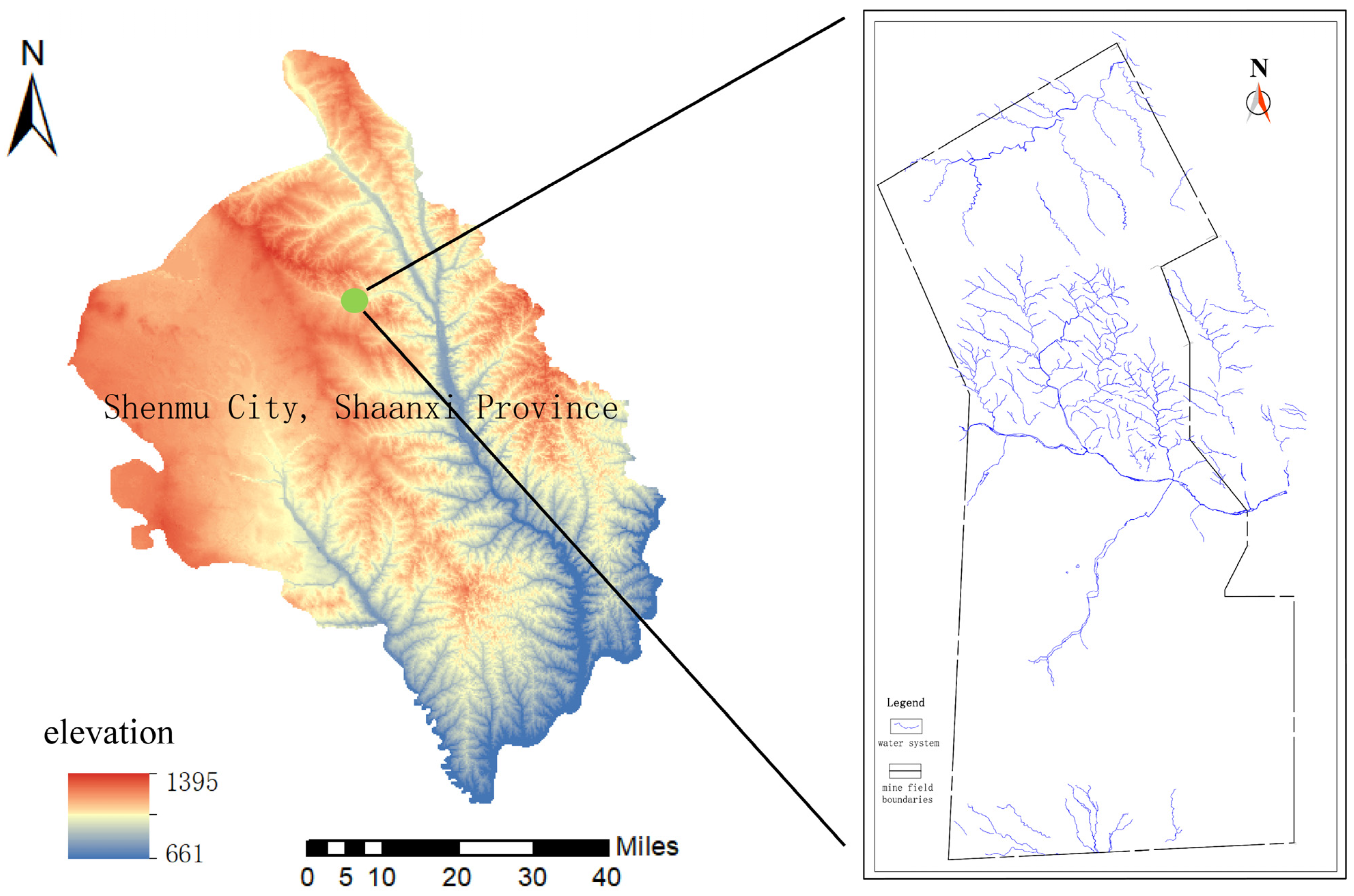
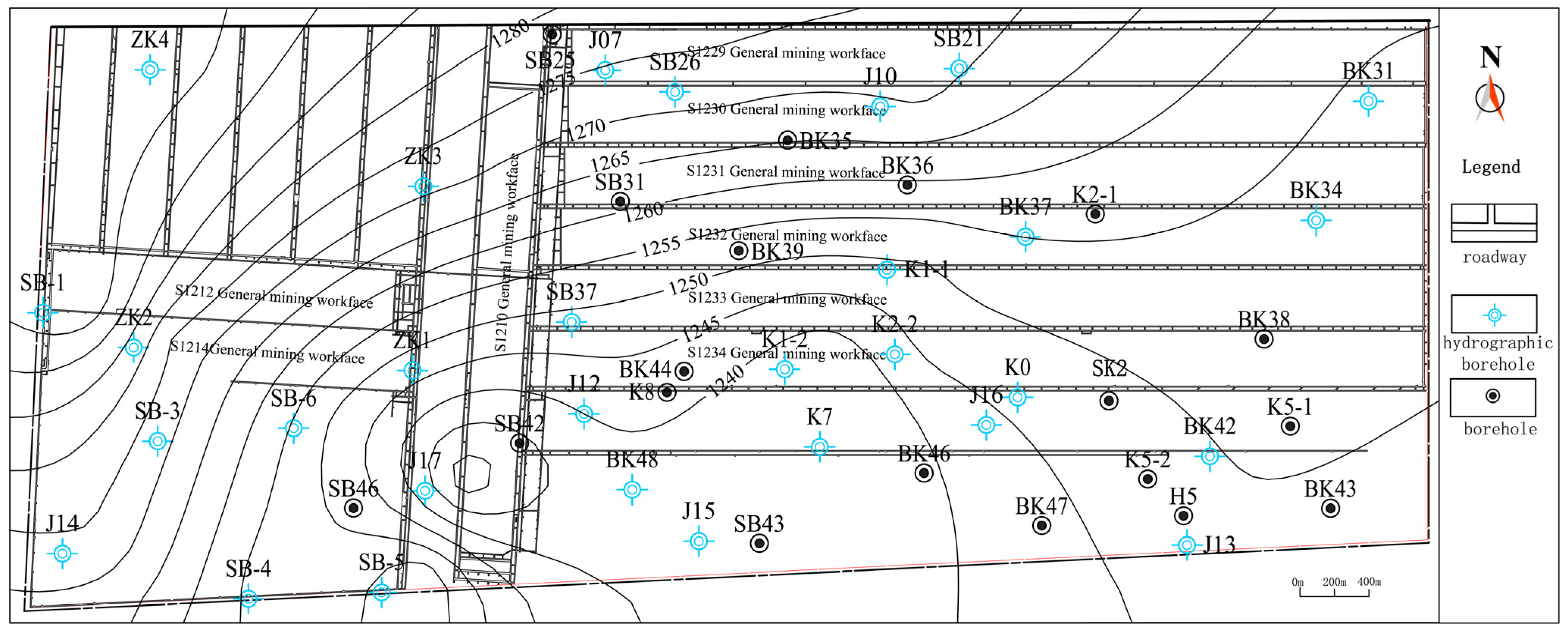
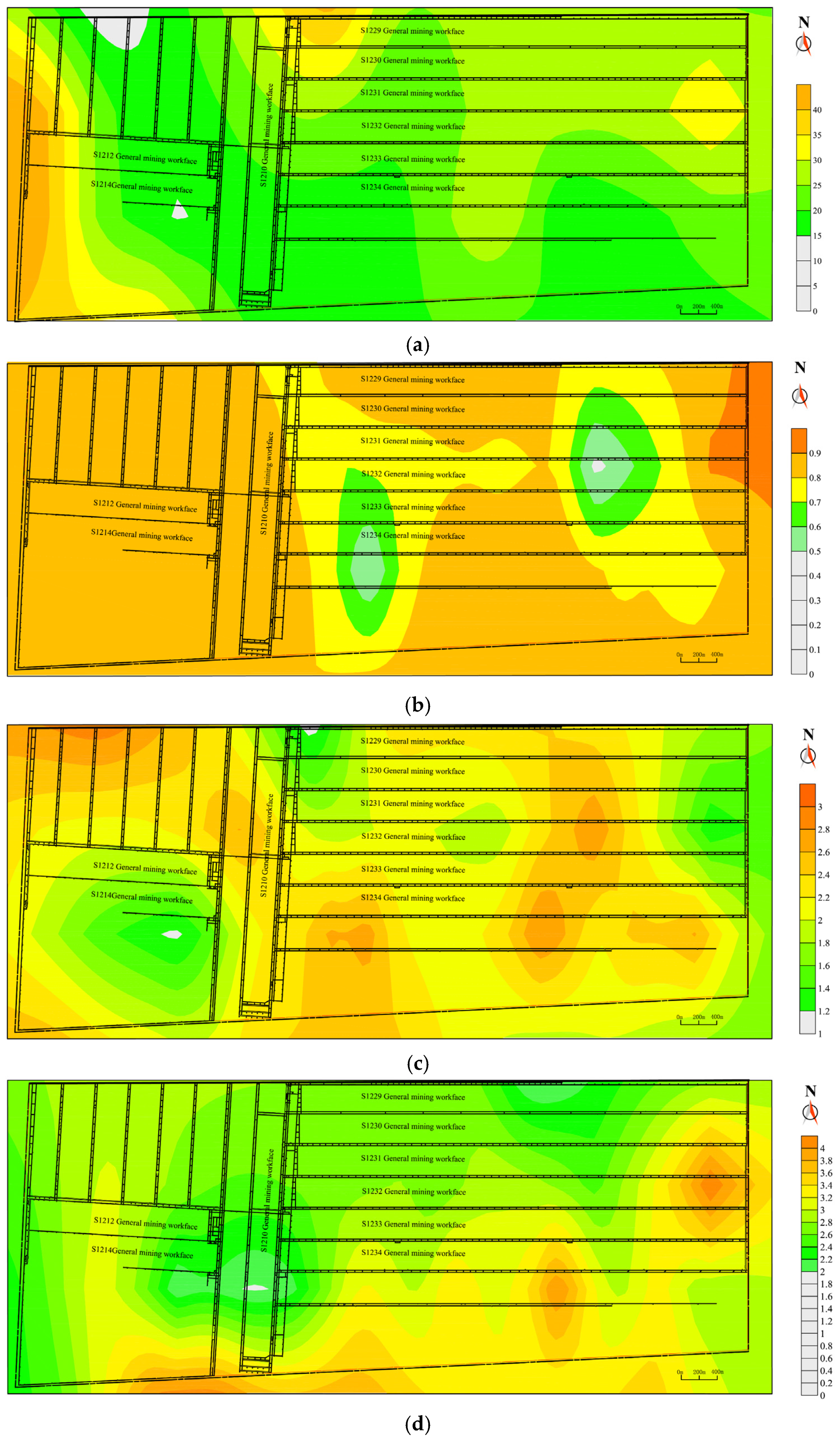

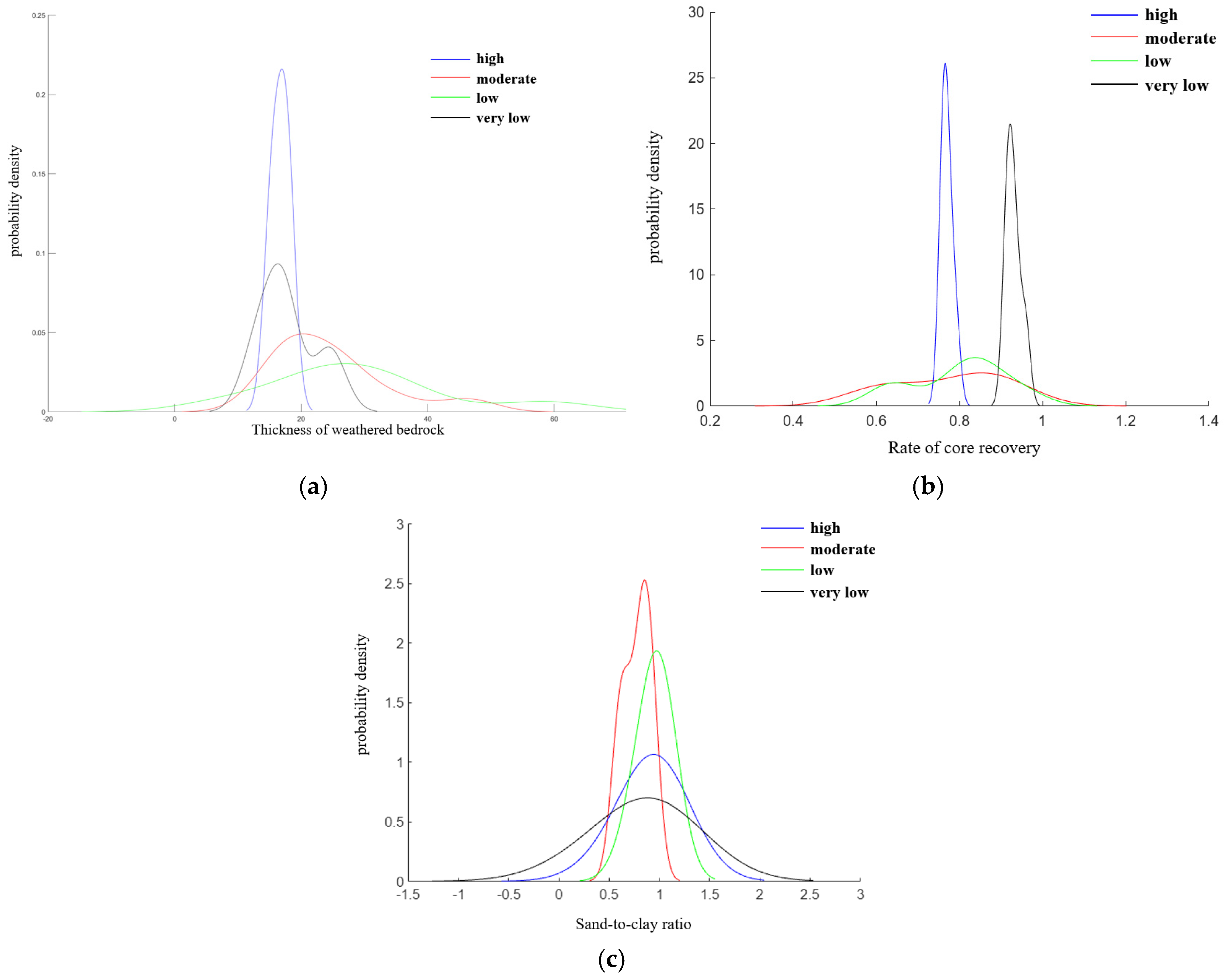
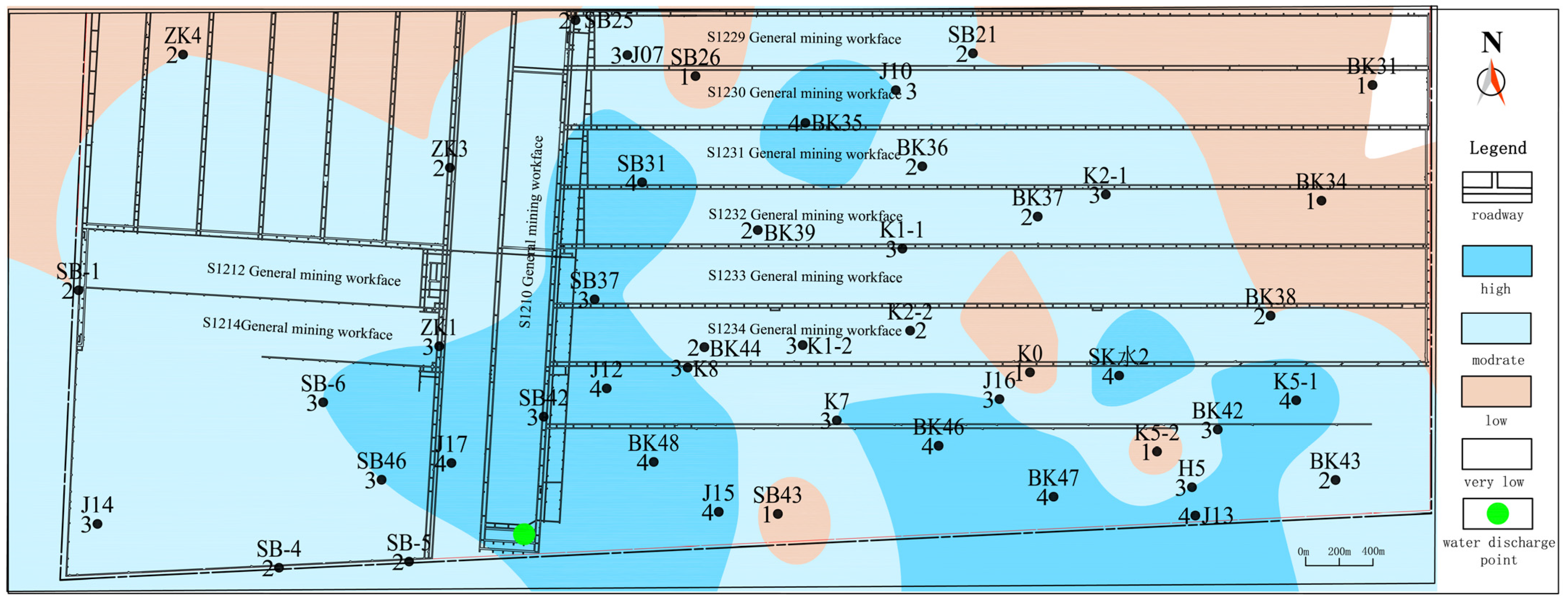
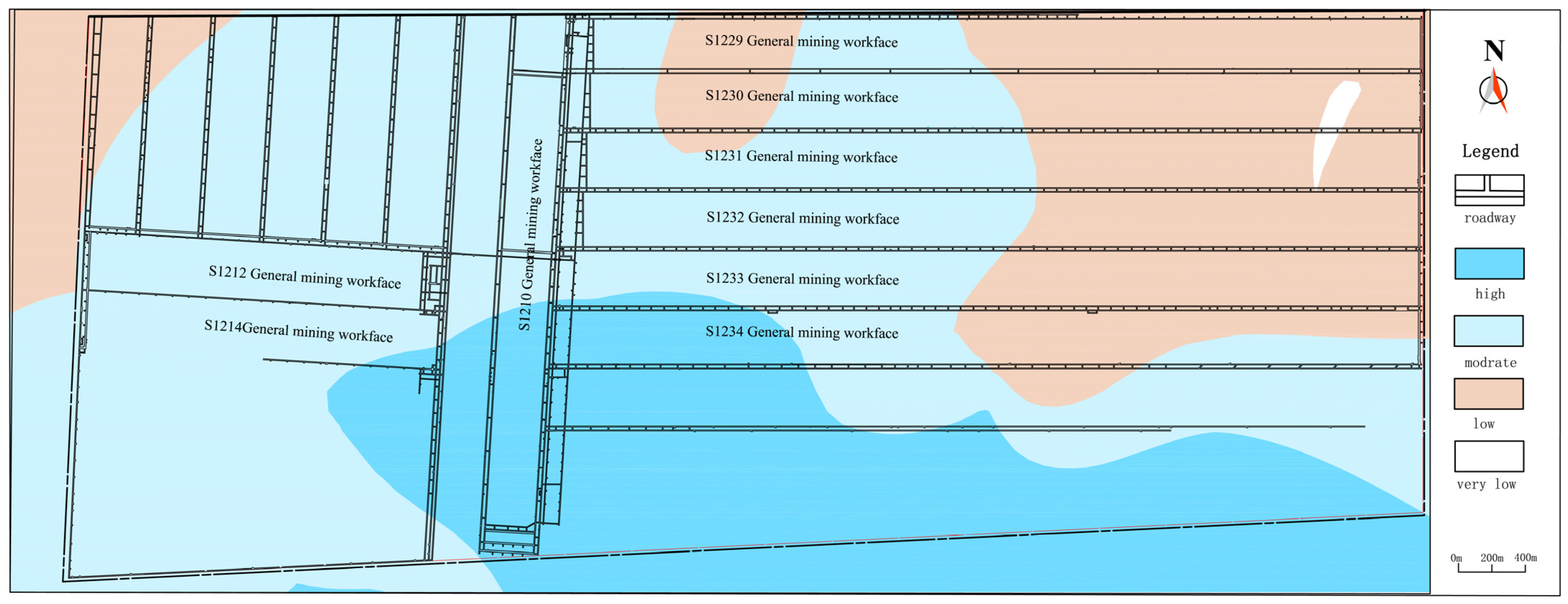

| Water-Bearing Property Classification | High | Moderate | Low | Very Low |
|---|---|---|---|---|
| Unit water inflow | > 1 | 1 ≥ > 0.1 | 0.1 ≥ > 0.01 | ≤ 0.01 |
| Value | 4 | 3 | 2 | 1 |
| Degree of Weathering | Strong | Moderate | Weak |
|---|---|---|---|
| Value | 3 | 2 | 1 |
| Lithology | Mudstones | Sandy Mudstone | Siltstone | Fine-Grained Sandstone | Medium-Grained Sandstone | Coarse-Grained Sandstone | Conglomerate |
|---|---|---|---|---|---|---|---|
| value | 1 | 1.5 | 2 | 3 | 4 | 5 | 6 |
| Borehole | Weathered Bedrock Thickness | Core Recovery Rate | Weathering Degree | Lithology Combination | Elevation of Weathered Bedrock Surface | Sand-to-Base Ratio |
|---|---|---|---|---|---|---|
| BK42 | 17.4 | 0.94 | 2.5 | 3.5 | 1209.282 | 1 |
| J12 | 16.9 | 0.76 | 2.66 | 2.68 | 1169.166 | 1 |
| J07 | 46.29 | 0.83 | 1.7 | 2.455 | 1213.209 | 0.9 |
| J10 | 27.54 | 0.78 | 2.12 | 3.45 | 1221.771 | 1 |
| J15 | 18 | 0.76 | 2.67 | 3.6 7 | 1180.52 | 1 |
| J13 | 15.6 | 0.77 | 2.15 | 3.69 | 1200.179 | 1 |
| BK31 | 24.5 | 0.93 | 1.62 | 2.97 | 1223.803 | 1 |
| SB26 | 16.81 | 0.92 | 2.74 | 3.08 | 1214.3 | 0.738 |
| ZK4 | 8.5 | 0.84 | 3 | 3 | 1209.75 | 1 |
| ZK2 | 18 | 0.89 | 1.3 | 3.7 | 1202.28 | 1 |
| J17 | 15.1 | 0.59 | 2.84 | 2 | 1182.554 | 0.76 |
| J14 | 34.63 | 0.82 | 2.47 | 2.13 | 1180.141 | 0.47 |
| ZK1 | 19 | 0.86 | 1.64 | 2.07 | 1193.75 | 1 |
| ZK3 | 22.8 | 0.85 | 2.91 | 2.66 | 1208.28 | 1 |
| SB-1 | 58.61 | 0.96 | 1.82 | 2.45 | 1203.892 | 0.53 |
| SB-6 | 14.62 | 0.91 | 1.13 | 2 | 1184.56 | 1 |
| SB-3 | 17.21 | 0.92 | 2.65 | 1.82 | 1183.708 | 0.65 |
| SB-4 | 35.4 | 0.63 | 2 | 4 | 1178.912 | 1 |
| SB-5 | 19.7 | 0.89 | 2 | 4 | 1178.468 | 1 |
| SB21 | 26.4 | 0.65 | 2.45 | 1.9 | 1245.05 | 0.27 |
| BK37 | 27.5 | 0.81 | 2.47 | 2.86 | 1218.972 | 1 |
| K1-2 | 19.23 | 0.63 | 2.13 | 1.96 | 1199.666 | 0.79 |
| K7 | 25.39 | 0.66 | 2 | 4 | 1194.172 | 1 |
| K2-2 | 34.65 | 0.78 | 2.46 | 2.67 | 1210.97 | 0.88 |
| J16 | 22.92 | 0.63 | 2.8 | 3.5 | 1207.795 | 1 |
| K0 | 13.01 | 0.67 | 2.83 | 4.49 | 1195.98 | 0.88 |
| K1-1 | 26.62 | 0.57 | 2.31 | 3.16 | 1213.087 | 0.91 |
| BK48 | 17.8 | 0.77 | 2 | 4 | 1180.929 | 1 |
| BK34 | 34.4 | 0.85 | 1.26 | 4.22 | 1232.042 | 1 |
| SB37 | 20.66 | 0.79 | 1.65 | 2.77 | 1195.27 | 1 |
| Name | Statistic W | p |
|---|---|---|
| Weathered bedrock thickness | 0.910 | 0.006 |
| Core recovery rate | 0.920 | 0.011 |
| Degree of weathering | 0.962 | 0.228 |
| Lithology combination | 0.968 | 0.367 |
| Elevation of the weathered bedrock surface | 0.976 | 0.581 |
| Sand-to-base ratio | 0.677 | 0.0 |
| Boreholes | Actual Water-Bearing Properties | Naive Bayes Discriminant | KDE–Bayes Discriminant | |
|---|---|---|---|---|
| Prediction group | J12 | 4 | 4 | 4 |
| J15 | 4 | 4 | 4 | |
| J13 | 4 | 4 | 4 | |
| J17 | 4 | 4 | 4 | |
| BK48 | 4 | 4 | 4 | |
| J10 | 3 | 2 | 3 | |
| ZK2 | 3 | 3 | 3 | |
| J14 | 3 | 3 | 3 | |
| ZK1 | 3 | 3 | 3 | |
| SB-6 | 3 | 3 | 3 | |
| K1-2 | 3 | 3 | 3 | |
| K1-1 | 3 | 3 | 3 | |
| SB37 | 3 | 3 | 3 | |
| ZK4 | 2 | 4 | 2 | |
| ZK3 | 2 | 2 | 2 | |
| SB-4 | 2 | 4 | 2 | |
| SB-5 | 2 | 4 | 2 | |
| BK37 | 2 | 2 | 2 | |
| K2-2 | 2 | 2 | 2 | |
| SB26 | 1 | 1 | 1 | |
| SB-3 | 1 | 1 | 1 | |
| K0 | 1 | 1 | 1 | |
| BK34 | 1 | 1 | 1 | |
| True positive rate (%) | 82.6 | 100 | ||
| Validation group | K7 | 3 | 3 | 3 |
| SB21 | 2 | 2 | 2 | |
| BK31 | 1 | 1 | 1 | |
| SB-1 | 2 | 2 | 2 | |
| BK42 | 3 | 2 | 3 | |
| J07 | 3 | 3 | 3 | |
| J16 | 3 | 4 | 3 | |
| True positive rate (%) | 71.4 | 100 | ||
| Boreholes | Weathered Bedrock Thickness | Core Recovery Rate | Degree of Weathering | Lithological Combination | Elevation of the Weathered Bedrock Surface | Sand-to-Base Ratio | Predicted Value |
|---|---|---|---|---|---|---|---|
| SB25 | 24.04 | 0.78 | 1 | 2.81 | 1201.15 | 1 | 2 |
| SB42 | 41.89 | 0.82 | 2.36 | 2.11 | 1190.98 | 0.503 | 3 |
| SB31 | 21.48 | 0.68 | 1.97 | 2.7 | 1204.84 | 0.91 | 4 |
| BK35 | 18 | 0.82 | 2 | 2 | 1224.212 | 1 | 4 |
| BK39 | 38.5 | 0.71 | 2 | 2.96 | 1221.559 | 1 | 2 |
| BK44 | 21 | 0.82 | 1.68 | 2.65 | 1188.136 | 1 | 2 |
| SB43 | 20.57 | 0.87 | 2.29 | 3.15 | 1191.98 | 0.7 | 1 |
| BK46 | 20 | 0.89 | 2 | 3 | 1208.47 | 1 | 4 |
| BK47 | 9.1 | 0.85 | 2 | 3 | 1191.008 | 1 | 4 |
| BK43 | 51.9 | 0.89 | 1.83 | 2.55 | 1261.345 | 1 | 2 |
| BK36 | 34 | 0.71 | 1.56 | 2.83 | 1219.665 | 1 | 2 |
| BK38 | 23.96 | 0.68 | 2 | 3 | 1223.233 | 1 | 2 |
| SK2 | 15.9 | 0.78 | 2 | 3.19 | 1214.699 | 1 | 4 |
| K5-1 | 21.9 | 0.74 | 2.66 | 2.88 | 1221.59 | 0.954 | 4 |
| K8 | 21.02 | 0.37 | 2.88 | 3.02 | 1191.146 | 0.66 | 3 |
| H5 | 25.7 | 0.88 | 2.95 | 2.21 | 1204.546 | 0.62 | 3 |
| K5-2 | 11.11 | 0.83 | 2.96 | 2.26 | 1195.907 | 0.7 | 1 |
| K2-1 | 24.1 | 0.45 | 2.78 | 2.475 | 1227.636 | 0.78 | 3 |
| Boreholes | Weathered Bedrock Thickness | Core Recovery Rate | Degree of Weathering | Lithological Combination | Elevation of the Weathered Bedrock Surface | Sand-to-Base Ratio | Actual Water-Bearing Properties | Predicted Value |
|---|---|---|---|---|---|---|---|---|
| Z6 | 51.95 | 0.64 | 1.46 | 3.07 | 1209.43 | 1.00 | 3 | 3 |
| Z4 | 14.57 | 0.86 | 1.00 | 4.00 | 1169.87 | 1.00 | 2 | 2 |
| Z3 | 14.50 | 0.40 | 3.00 | 4.00 | 1172.53 | 1.00 | 3 | 3 |
| B23-25 | 20.00 | 0.83 | 1.00 | 1.96 | 1118.13 | 0.31 | 2 | 2 |
| B23-23 | 37.25 | 0.88 | 1.00 | 3.89 | 1196.41 | 1.00 | 3 | 4 |
| B23-9 | 12.64 | 0.94 | 1.00 | 4.00 | 1184.76 | 1.00 | 3 | 3 |
| L24 | 16.15 | 0.86 | 3.00 | 4.00 | 1167.56 | 1.00 | 3 | 3 |
| L18 | 21.80 | 0.80 | 2.31 | 3.73 | 1110.76 | 1.00 | 3 | 3 |
| SK9 | 16.25 | 0.65 | 1.00 | 3.50 | 1198.90 | 1.00 | 2 | 2 |
| HB2-8 | 29.72 | 0.44 | 2.25 | 4.07 | 1194.23 | 0.75 | 4 | 3 |
Disclaimer/Publisher’s Note: The statements, opinions and data contained in all publications are solely those of the individual author(s) and contributor(s) and not of MDPI and/or the editor(s). MDPI and/or the editor(s) disclaim responsibility for any injury to people or property resulting from any ideas, methods, instructions or products referred to in the content. |
© 2025 by the authors. Licensee MDPI, Basel, Switzerland. This article is an open access article distributed under the terms and conditions of the Creative Commons Attribution (CC BY) license (https://creativecommons.org/licenses/by/4.0/).
Share and Cite
Hou, E.; Hou, J.; Ma, L.; He, T.; Zhang, Q.; Gao, L.; Gao, L. Prediction of the Water-Bearing Properties of Weathered Bedrock Aquifers Based on Kernel Density Estimator–Bayes Discriminant. Appl. Sci. 2025, 15, 1367. https://doi.org/10.3390/app15031367
Hou E, Hou J, Ma L, He T, Zhang Q, Gao L, Gao L. Prediction of the Water-Bearing Properties of Weathered Bedrock Aquifers Based on Kernel Density Estimator–Bayes Discriminant. Applied Sciences. 2025; 15(3):1367. https://doi.org/10.3390/app15031367
Chicago/Turabian StyleHou, Enke, Jingyi Hou, Liang Ma, Tao He, Qi Zhang, Lijun Gao, and Liang Gao. 2025. "Prediction of the Water-Bearing Properties of Weathered Bedrock Aquifers Based on Kernel Density Estimator–Bayes Discriminant" Applied Sciences 15, no. 3: 1367. https://doi.org/10.3390/app15031367
APA StyleHou, E., Hou, J., Ma, L., He, T., Zhang, Q., Gao, L., & Gao, L. (2025). Prediction of the Water-Bearing Properties of Weathered Bedrock Aquifers Based on Kernel Density Estimator–Bayes Discriminant. Applied Sciences, 15(3), 1367. https://doi.org/10.3390/app15031367





